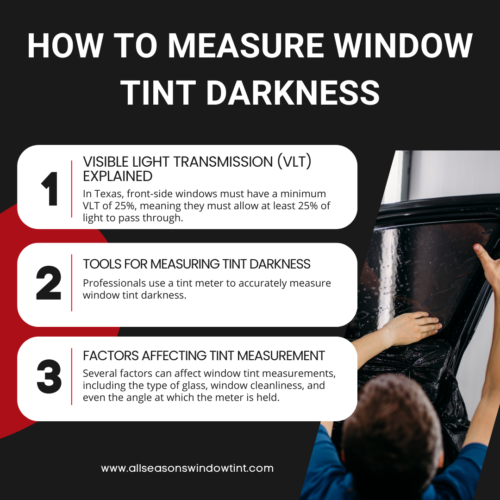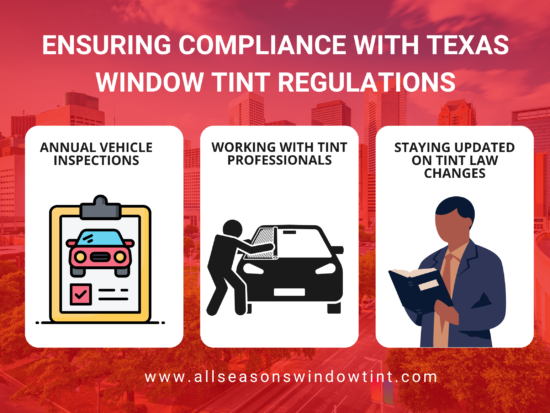Want to upgrade your ride with both style and comfort? Look no further than legal front window tint!
Sure, “legal” might not sound like the hottest topic, but it’s more than meets the eye.
Here’s the deal: the right tint can block harsh sunlight, fight glare, and even shield your skin and eyes. Plus, it adds a sleek, mysterious touch to your car.
But there’s a catch – window tint laws exist, and following them is critical to avoiding trouble. Ready to unlock the world of legal front window tint?
We’ll explore what’s allowed, what’s a no-go, and how to pick the perfect tint for your vehicle.
Ready to reduce glare, protect your privacy, and enhance the appearance of your vehicle or building?
Contact All Seasons Window Tinting today for a free consultation and quote.
Table Of Contents:
- Understanding Texas Window Tint Laws
- How to Measure Window Tint Darkness
- Obtaining a Medical Exemption for Window Tint in Texas
- Choosing Legal Window Tint for Your Vehicle
- Ensuring Compliance with Texas Window Tint Regulations
- FAQs in Relation to Legal Front Window Tint
- Hit the Road with Confidence: The Legal Front Window Tint Advantage
Understanding Texas Window Tint Laws
If you’re a Dallas-Forth Worth Texas driver, it’s crucial to understand the state’s window tint laws. These regulations ensure the safety of everyone on the road.
As professionals in the window tinting industry, we have seen firsthand how important it is to stay compliant.
Legal Tint Limits for Texas Vehicles
The legal limit for window tint darkness in Dallas-Forth Worth Texas varies depending on the vehicle type and window location.
A legal tint can only be applied to a specific windshield area for passenger vehicles. This area is either above a designated mark called the AS-1 line or the top 5 inches, whichever is lower.
The front-side windows must allow at least 25% light transmission. The back side windows and rear windows have no restrictions on tint darkness.
Penalties for Violating Tint Laws
Failing to comply with Texas window tinting laws can result in hefty fines and even legal consequences.
According to the Texas Department of Public Safety, a first-time offender may face a fine penalty. Repeat offenders can expect even steeper penalties. It’s simply not worth the risk.
Exceptions to Texas Tint Laws
There are a few exceptions to the standard Texas window tint laws.
For example, individuals with certain medical conditions may qualify for a medical exemption, allowing them to have darker tints on their vehicle’s windows.
Additionally, some types of vehicles, such as government or commercial vehicles, may be exempt from the usual tint restrictions.
How to Measure Window Tint Darkness
Knowing how to measure window tint darkness is essential for staying within legal limits. The most common method is visible light transmission (VLT) percentage.
 Visible Light Transmission (VLT) Explained
Visible Light Transmission (VLT) Explained
VLT measures the amount of visible light that passes through a window.
In Texas, front-side windows must have a minimum VLT of 25%, meaning they must allow at least 25% of light to pass through.
The lower the VLT percentage, the darker the tint.
Tools for Measuring Tint Darkness
Professionals use a tint meter to accurately measure window tint darkness. This device measures the light that passes through the window and provides a VLT percentage reading.
As a window tint expert, we always recommend using a reliable, calibrated tint meter to ensure accurate measurements.
Factors Affecting Tint Measurement
Several factors can affect window tint measurements, including the type of glass, window cleanliness, and even the angle at which the meter is held.
It’s crucial to take measurements in a controlled environment and to follow proper procedures to ensure accurate readings.
Obtaining a Medical Exemption for Window Tint in Texas
For some individuals, a darker window tint is a medical necessity. In these cases, a medical exemption from the standard Dallas-Forth Worth Texas tint laws is possible.
Qualifying Medical Conditions for Tint Exemption
To qualify for a medical exemption, you must have a medical condition that requires reduced light exposure. Some common qualifying conditions include lupus, photosensitivity, and certain skin disorders.
A licensed physician must provide a signed statement confirming the medical necessity for darker window tint.
Required Documentation for Exemption
To obtain a window tint exemption in Texas, you must provide a signed medical exemption statement from your licensed physician.
This statement should clearly state your medical condition and the need for a darker window tint. Keep this documentation in your vehicle at all times.
Renewing Your Tint Exemption
Medical window tint exemptions in Texas are valid if you still have the medical condition.
You’ll need to submit a new signed medical exemption statement from your physician to renew your exemption.
Staying on top of your exemption status is essential to avoid legal issues.
Choosing Legal Window Tint for Your Vehicle
When selecting window tint for your Texas vehicle, choosing a product that complies with state laws is essential. Here are some key factors to consider:
Types of Legal Window Tint Films
Several types of window tint films are available that meet Texas legal requirements.
These include dyed, metalized, and ceramic films. Each type has its benefits, such as heat rejection, UV protection, and glare reduction.
Benefits of UV-Blocking Tint
In addition to reducing heat and glare, legal window tint can provide valuable UV protection for you and your passengers.
UV-blocking films can help prevent skin damage and premature aging caused by harmful UV rays. They also help protect your vehicle’s interior from fading and cracking.
Maintaining Your Legal Window Tint
To keep your legal window tint looking and performing its best, it’s important to properly maintain it. Regular cleaning with a mild soap and soft cloth can help prevent buildup and scratches.
Avoid using abrasive cleaners or rough materials that could damage the tint film.
Ensuring Compliance with Texas Window Tint Regulations
Staying compliant with Texas window tint laws is crucial for avoiding fines and legal troubles. Here are some tips to help ensure your vehicle’s tint remains within legal limits:
 Annual Vehicle Inspections
Annual Vehicle Inspections
In Texas, all vehicles must undergo an annual safety inspection. During this inspection, your window tint will be checked for compliance with state laws.
If your tint is found to be too dark or reflective, you may be required to remove it before your vehicle can pass inspection.
Working with Tint Professionals
Working with experienced tint professionals like us at All Seasons Window Tinting is the best way to ensure your window tint is installed correctly and legally.
We have the knowledge and tools to select and install legal window tint films that meet Texas regulations.
We can also provide guidance on maintaining your tint and staying compliant with the law.
Staying Updated on Tint Law Changes
Texas window tint laws can change over time, so staying informed about updates or revisions is essential.
The Texas Department of Public Safety regularly provides information on tint regulations through its website and other resources.
As a responsible vehicle owner, you are responsible for staying current on these laws and ensuring your window tint remains compliant.
FAQs in Relation to Legal Front Window Tint
What is the darkest legal tint for front windows?
You can go as dark as 25% VLT in Texas on your front side windows. Keep it above that to stay legal.
Can I tint my front windshield in Texas?
You bet, but only the top 5 inches or with a strip that meets the same light standards—nothing more.
How much is a tint ticket in Texas?
It’s around $20 to $275, depending on your county and whether you’ve been nailed for this before. It adds up quickly.
What is the best tint percentage for a front windshield?
The sweet spot? Aim for non-reflective tint above the AS-1 line, or just stick with clear UV film to avoid trouble.
Are there any penalties for violating Texas car window tinting laws?
Violating Texas car window tinting laws can result in a misdemeanor, carry fines, and potentially require the removal of the non-compliant tint.
Hit the Road with Confidence: The Legal Front Window Tint Advantage
So there you have it, the ins and outs of legal front window tint. It’s not just about looking cool; it’s about staying safe, comfortable, and on the right side of the law.
Remember, each state has its rules, so always double-check before you tint.
And if you have a medical condition that requires a darker tint, remember to get that exemption form.
At the end of the day, a little bit of knowledge goes a long way when it comes to legal front window tint.
You can confidently ride along the highway, knowing your tint is stylish and compliant.
So go ahead, give your ride that extra personality, and enjoy the benefits of a well-tinted car. Remember to keep it legal, and you’ll be good to go!
Enhance your space’s comfort, style, and efficiency with All Seasons Window Tinting.
Our expert window tinting services can help you achieve the perfect balance of functionality and aesthetics. Don’t wait, contact us today!

